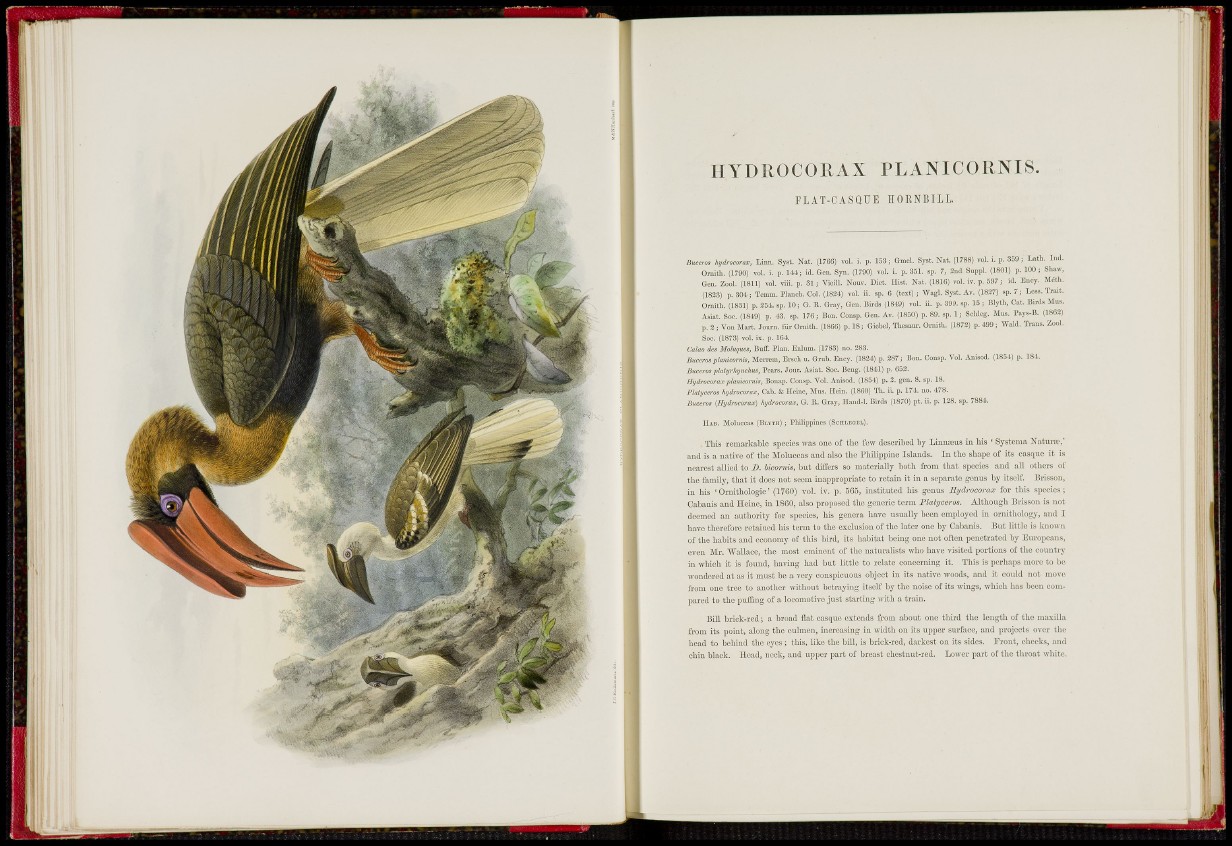
llYDROCOßAX PLANICORNIS.
F L A T - C A S Q U E IIORNliILL
BuceroB hydrocorax, Lina. Syst. Nat. (1766) vol. i. p. 153 j Gmcl. Syst. Nat . (1788) vol. i. p. 359; Lath. Ind.
Oruith, (1790) vol. i. p. 144; id. Gen. SyB. (1790) vol. i. p. 351. sp. 7, 2ud Suppl. (1801) p. 100; Shaw,
Gen. Zool. (1811) vol. viii. p. 31; Vieill. Nouv. Diet. Ilist. Nat. (1810) vol. iv. p. 597; id. Eney. Meth,
(1823) p. 30-1.; Temm. Planeh. Col. (182^1) vol. ii, sp. 6 (text) ; Wagl. Syst. Av. (1827) sp. 7 ; Less. Trait.
Omith, (1831) p. 254. sp. 10; G. 11. Gray, Gen. Bii'ds (184.9) vol. ii. p. 39i). sp. 15 ; Blyth, Cat. Birds Mus.
Asiat. Soc. (1849) p. 43. sp. 176; Bon. Consp. Gen. Av. (1850) p. 89. sp. 1 ; ScHeg. Mus. Pays-B. (1862)
p. 2 ; Von Mart. Journ. für Ornitli, (1866) p. 18; Giebel, Thesaur. Ornitii. (1872) p. 4 9 9 ; Wald. Trans. Zool.
Soc. (1873) vol. ix. p. 164
Valao des Moluques, Buff. Plan. Eulum. (1783) uo. 283.
Buc<^ros phnicornis, Merrem, I r sch u. Grub. Eney. (1824) p. 287; Bon. Consp. Vol. Anisod. (1851) p. 184.
Buccros platijrhynchus, Pears. Jour. Asiat. Soc. Beng. (1841) p. 652.
tlydrocorax planicornis, Bonap. Consp. Vol. Anisod. (1854) p. 2. gen. 8. sp. 18.
Platycei-os hydrocorax, Gab. & I leiuc, Mus. Hein. (1860) Tli. ii. p. 171, no. 478.
Tiuceros [Hydrocorax) hydrocorax, G. 11. Gray, Iland-l. Birds (1870) pt. ii. p; 128. sp, 7884.
II-^B. Moluccas (BLYTH); Philippines (ScntisoEL).
This remarkaljle species -n-as one of the few described hy Linntcus in his ' Systerna Natura>,'
and is a native of the Jloluccas and also the I'hiUppine Islands. In the shape of its casque it is
nearest allied to D. bicornia, but differs so materially both from that specics and all others of
the family, that it does not seem inappropriate to retain it in a separate genus by itself. Erisson,
in his 'Ornithologie' (17G0) vol. iv. p. 565, instituted Ms genus JIydrocora<t for this species;
Cabanis and Heine, in 1860, also proposed the generic term I'latyceros. Although Brisson is not
deemed an authority for species, his genera have usually been employed in ornithology, and I
have therefore retained his term to the exclusion of the later one hy Cabanis. But little is known
of the habits and economy of this bird, its habitat being one not often penetrated hy Europeans,
even Mr. Wallace, the most eminent of the naturalists who have visited portions of the country
in which it is found, having had bat little to relate concerning it. Tliis is perhaps more to be
wondered at as it must be a very conspicuous object in its native woods, and it could not move
li-om one tree to another without betraying itself by the noise of its wings, which has been compared
to the puffing of a locomotive j ast stai-ting with a train.
Bill brick-red; a broad flat casque extends from about one third the length of the maxilla
from its point, along the culmen, increasing in width on its upper surface, and projects over the
head to behind the eyes ; this, like the bill, is briek-red, darkest on its sides. Pront, cheeks, and
eliin black. Head, neck, and upper part of breast chestnut-red. Lower part of tlie throat white.